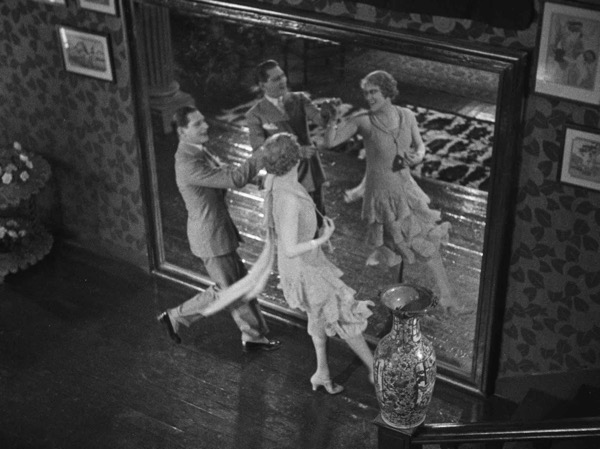LA FEMME RÊVÉE
(La donna sognata)
Jean Durand (FR 1929)
In his early years with Gaumont, Jean Durand (1882-1946) helped to originate the burlesque in French cinema, producing several series with recurring comic heroes, including such outstanding figures as Calino (Clément Mégé), Zigoto (Lucien Bataille), and Onésime (Ernest Bourbon), as well as the knockabout troupe of comedians known as “Les Pouics”, who came from the circus. Later, in the 1920s, he was converted to dramatic fiction. This was not entirely a novelty for him, since over a decade earlier he had created the Western à la française, shot in the Camargue and based on scripts by Joë Hamman, who was also their star. [Several of these “Camargue Westerns” are being shown at this year’s Giornate, in the third instalment of the “Beginnings of the Western” series.]
After the First World War, Durand shot a series of five feature films with his wife Berthe Dagmar, a dauntless animal-tamer and stuntwoman, in which she played the heroine Marie: Marie la gaîté, Marie chez les loups, Marie chez les fauves, Marie la femme au singe, and Face aux loups. In 1926, with her assistance, Durand made Palaces, followed in 1927 by L’Île d’amour, two films à grand spectacle which reveal his taste for propriety, and for love stories whose protagonists seem to have come right out of the popular literature of the Roaring Twenties – the kind written by Victor Margueritte or Maurice Dekobra.
In 1928, he took on La Femme rêvée, a more ambitious film than his earlier productions. Shot in Andalusia, Nice, the Camargue and Paris, it features such stars as Arlette Marchal, Alice Roberts, Charles Vanel, and the dancer Harry Pilcer, the legendary partner of Mistinguett (whom the director had tried to tempt back to the movies in L’Île d’amour). La Femme rêvée abounds with spectacular sequences, and Durand shoots with gusto around the great April fiesta in Seville and among a herd of bulls fleeing during a thunderstorm. For the sequences in Paris, he shot scenes at the swimming pool and tea room of the Paris Lido; society auto races at the Montlhéry circuit; a reception that allows us to admire the latest haute couture fashions from the Maison Jenny; and the dizzying finale at the Casino de Paris, the celebrated music hall where Harry Pilcer was starring in the revue Paris qui chante.
The plot has an old-fashioned charm and is not without interest: a man who has fallen for two women imagines he can love them both at the same time, creating a sort of hybrid “ideal woman”. Yet beyond the basics, La Femme rêvée can be regarded as bearing passionate witness to silent cinema – still attached to its formal certainties, its artistic beauty, and its infatuation with exoticism and the photogenic qualities of landscapes and people.
Freely inspired by a novel by the great Spanish journalist José Pérez de Rozas (1882-1959), with a preface by Vicente Blasco Ibáñez, La Femme rêvée is solidly situated in the theatrical tradition of works that in the 1920s excited – and occasionally scandalized – public opinion, which was still sensitive to evolving morals after the ordeal of the Great War. Adopting the form of an apparently anodyne bourgeois drama (a husband, a wife, and a lover), Jean Durand addresses the red-hot topics of the day: female freedom, love triangles, forbidden pleasures of the nocturnal world….
The film benefits from some prestigious casting, headed by Charles Vanel, who had just appeared as Napoleon in Karl Grüne’s epic Berlin production Waterloo, and who no doubt brought with him the austere presence and acting style associated with some star actors of the German screen. Playing alongside him as his leading ladies are Alice Roberts, who had been chosen by G. W. Pabst to play the part of the sulphurous Countess Geschwitz in Pandora’s Box, and the statuesque Arlette Marchal, who had become a star in 1927 thanks to her role as Countess Orloff in La Châtelaine du Liban by Marco de Gastyne, adapted from the novel by Pierre Benoit. The cast also includes some remarkably appealing performers of whom Durand was clearly fond: the great flamenco dancer Vicente Escudero, and Harry Pilcer, who introduced the Charleston to Europe and was the music hall partner of Gaby Deslys, Mistinguett, Jenny Golder, and the Dolly Sisters.
Considered lost and not even mentioned in most histories of the cinema, the film was recently restored in the nick of time thanks to the discovery of two original nitrate negatives, reflecting the twin camera takes of cinematographers Paul Parguel (one of Jean Epstein’s favourite cameramen) and Jéhan Fouquet. Although the production was trumpeted everywhere by Franco-Film, La Femme rêvée (reviewed in France by Variety as The Ideal Woman) came out at the worst possible moment, just as silents were being replaced by talkies. The Jazz Singer was released in France earlier that year, in January 1929, and even The Passion of Joan of Arc was given the cold shoulder by audiences in this new era of cinema. Jean Durand’s career never recovered. He made his last film, Détresse, the following year, before sinking into oblivion and poverty.
Pierre Philippe

regia/dir, scen, adapt: Jean Durand, da un romanzo di/based on a novel by José Pérez de Rozas (La mujer soñada, 1928).
cast: Arlette Marchal (Suzanne Fleury), Charles Vanel (Angel Caal), Alice Roberts (Mercédès), Harry Pilcer (ballerino/the dancer, Harry), Tony D’Algy (Mariona), Thérèse Kolb (vecchia governante/duenna), Jeanne Grumbach (zia/aunt).
prod: Franco-Film.
uscita/rel: 27.02.1929 (anteprima per esercenti/trade screening); 04.07.1929.
copia/copy: DCP (orig. l: 2680 m.), c.120’; did./titles: FRA.
fonte/source: Gaumont Pathé Archives, Saint-Ouen, Paris.


 Italiano
Italiano